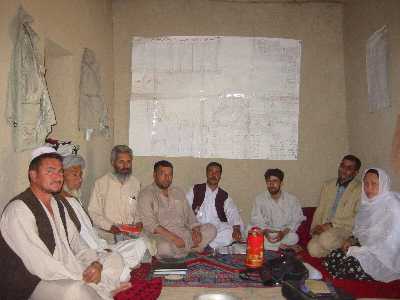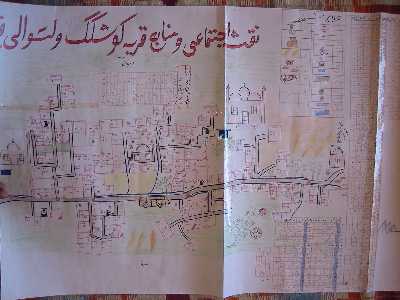Governance Structures in a Post Conflict Environment - Principles and General Procedures
|
|
Some Principles and Pre-conditionsReconstruction of a country and the necessary governance changes require some pre-conditions:
Photo 3: The relics of armed conflict
Photo 4: Traditional nomads
|
|
|
Creation of a National ProgrammeA National Programme needs to be formed: The aim of the Programme is to develop the ability of local communities to identify, plan, manage, and monitor their own development projects. The national programme needs to promote a development paradigm whereby communities are empowered to make decisions and control resources during all stages of the project cycle. The programme is expected to lay the foundations for a long-term strengthening of local governance, to make it more inclusive (e.g. for women, Internally Displaced Persons, returnees, ethnic minorities), and to provide assistance for reconstruction and development of communities.The goal of the National Programme would be to reduce poverty through empowering communities with regard to improved governance, and social, human, and economic capital. The objectives of the programme are to:
Photo 5: Emancipating the communities
Photo 6: The future of a village
|
|
|
Creation of Implementing StructuresA national executing ministry has to be selected: Ideally, a national ministry such as Ministry of Local Governance or Ministry of Rural Development is best suited to take on the role of being the national executing agency. The national executing agency should would promote a unique development paradigm whereby communities can make important decisions and control resources at all stages of development. This will ultimately enable all villages and communities to be eligible for funding through the National Programme. Within the ministry, Steering or oversight committee should manage the National Programme. The objective of the committee is not only to coordinate the National Programme but also to ensure that capacity for community development and programme management is developed and strengthened. This process may require external consultancy support. |
|
|
Facilitating PartnersIn most post conflict environments the administrative and political structures are not available on the side of the state that can take over the development roles and functions. Often there are numerous Non-Governmental and UN Organisations in the country, mainly involved in relief work. These organisations have the necessary administrative and organisational capacity to reach out to the people living in nearly all parts of the country. These organisations are ideally suited to becoming so called “facilitating Partners”.The primary role of the Facilitating Partner is to provide support and guidance to the community in meeting the requirements of the National Programme. The Facilitating Partners are expected to report to the National Programme Steering Committee. In each province or region one or more Facilitating Partner would deploy community facilitators and technical specialists for one or more districts to cover a certain number of communities or villages. The Facilitating Partners may use facilitation methods that they deem appropriate while respecting the eligibility criteria to achieve the outputs against which the eligibility of community project proposals are appraised and may also plan the deployment of their staff and sequencing of activities in ways they consider optimal for achieving their overall output targets. |
|
|
Operations manualIn order to be able to effectively and efficiently implement the National Programme, an operations manual has to be developed. Quality of process is essential for the long-term sustainability of community investments and for the success of a programme. As such, community level planning must follow an approach that complies with the basic principles below:
|
|
|
DonorsPost conflict environments often bear the scars of years of civil unrest and war; one of the least available factors is any form of financial resources. The realization and continuation of any National Programme aiming at enabling the community to rebuild and develop their shattered lives is dependent on the commitments of donor countries and institutions.While donor funds can be helpful in securing initial resources required for the development work, in the medium term the national government needs to provide the necessary resources required for the development work |
|
|
Block grantsA key ingredient for the success of the National Programme is the provision of Block grants. These grants are allocated directly to the community. While this is initially only sustainable due to the contributions of the donor organisations, it would require a similar allocation by the Ministry of Finance. Examples exist in the world (i.e. Nepal) where block grants are allocated to every village level development council / committee in the country and to each district council. These block grants are allocated for developmental investment purposes and not for use for recurrent expenditures. The block grants to villages are intended to act as catalysts and at the same time provide much needed support for local reconstruction and development activities.Cyclical phases of the National ProgrammeA “5-Phase-Cycle” can be applied as a guide for the annual implementation process. The cyclical approach inherently contains a “loop-back” function.
Figure 1: Development Council Election Process & Council Meetings |
|
|
Basic annual stepsWithin the five phase cycle described above, the following steps need to be undertaken by the Facilitating Partners, the Communities / Villages and the National Programme:
|
|
|
1. Selection of communities
|
|
|
2. Preparation of the CommunitiesFacilitating Partners are expected to facilitate the process so that communities can jointly plan and implement projects in partnership with the National Programme. The FPs are expected to help:
a) facilitating community access to technical assistance
available in the market or from other agencies; or, b) technical assistance provided by the Facilitating Partner,
|
|
|
3. Appraisal of community development projects/ plansThe community (with the assistance of the Facilitating Partner) will complete and submit a Community Development Plan and standard sub-project proposal(s) (including technical designs and cost schedules) to the provincial representative of the NSP. The Community Development Plan constitutes a medium term investment plan for a particular community, which would provide the basis for additional future development activities whether funded by the National Programme or other sources, and also represent for the first time ever a bottom-up input to higher level planning at the district, provincial, and national level.Appraisal of the community proposal and budget are conducted by the National Programme. The Facilitating Partner helps communities to prepare and implement sub-project proposals and be positioned as “allies” of the community, while the National Programme staff formally appraises proposals and makes funding decisions. While the National programme is ultimately responsible for appraisal of all community project proposals to determine whether they meet the eligibility criteria, where possible, the decision making should be undertaken decentralised at the provincial levels. Only large project should be submitted to the national level for approval.. Selection can be completed using a standard appraisal tool and should involve line agency staff wherever and whenever possible. The appraisal is to be done using a transparent procedure with eligibility criteria, indicators and means of verification. The criteria are made known to the community in order to limit the discretionary power of the National Programme. A proposal is evaluated based on these criteria and assessed participatory meetings to be conducted every two-months in the districts. During appraisal visit by qualified engineers the appropriate levels of instalments will be discussed and agreed upon. In the absence of special agreements instalments could be 50%, 40% and last instalment of 10 %. The community will be informed regarding the result of the appraisal, which may be
Upon completion of appraisal and approval by the National Programme of a community project proposal, a Tripartite Agreement is signed between the Community Development Council, National Programme, and the Facilitating Partner regarding the financing of the sub-project, disbursement schedule and benchmarks triggering instalments and the general obligations of each of the parties to the agreement |
|
|
4. Project implementationThe primary responsibility for project implementation rests with the community (the Community or Village Development Council, Project Management Committee, and the greater community). Clear divisions of responsibility between the Development Council members and Project Management Committee members increase accountability. Three or more persons at the community level should be identified as responsible for most implementation activities such as procurement, bookkeeping, supervision, storage and accounting. This not only promotes transparency and continuity at the community level but ensures as well that more than one person in the community has the necessary skills/training to perform the task.Depending on the type of project, the community is either capable of undertaking implementation itself, or may require external assistance regarding specialized technical skills or services (e.g. masons for school construction, or lining and hand pump installation for dug wells for drinking water). If a community is using its block grant for more than one project, parallel implementation is an option, if sufficient capacity is present, since this speeds up overall implementation, and enables completion of projects within the constraints defined by local climate and altitude. The Facilitating Partner supports the community during this process with regard to:
|
|
|
5. Monitoring of the implementation process by the communityThe community wide assembly has to agree on the methods and schedule of reporting to the community (on financial and physical progress) by the Community or Village Development Council and the relevant Project Management Committees. The methods for information dissemination should ensure that women are informed about project activities. The community has to agree on key indicators to monitor joint decision-making, project progress, and transparency. Monitoring against these indicators has to be reported in the Community Progress Reporting Form used by the Facilitating Partners.In the community, all records and accounts must be available for inspection by the members of the community, the Facilitating Partner, and the National Programme. The arrangements to ensure transparency include regular community wide information meetings, display of all relevant information on implementation progress and expenditures on notice boards accessible to the public, and/or announcements of project-related information at community gatherings. |
|
|
6. Physical and financial progress monitoringThe Facilitating Partner is responsible for physical and financial progress monitoring on a quarterly basis with more comprehensive annual reports. The Facilitating Partner reports to the National Programme on process, achievement of implementation benchmarks, and quality of works as defined in the Tripartite Agreement. Achievement of implementation benchmarks will be tied to the release of funding to the community.The National Programme staff performs sample audits of the support for the community carried out by the Facilitating Partner regarding elections of Community Development Councils, preparation of sub-project proposals that comply with National Programme eligibility criteria, recommendations for release of block grant instalments based on achievement of agreed milestones, and the adequacy and realism of progress reporting |
 |
7. Project CompletionA completion report has to be prepared by the community and the Facilitating Partner. The completed project is inspected by the National Programme and a Certificate of Completion is issued to the community provided the sub-project is technically sound and that all funds received from National Programme have been reconciled. The National Programme may approve that any savings that are remaining may be allocated to be used by the community to increase the scope of the community development plan during the current or following year. |
 |
8. Final monitoring and evaluationThe National Programme requires a functioning monitoring and evaluation (M&E). The system is intended to provide adequate information to the relevant stakeholders on project implementation performance, process, outputs, and outcomes. The main purpose of the monitoring system is to provide timely feedback to key stakeholders, and permit mid-course corrective action initiated where necessary. The M&E system should have four components:
At the community / village level, communities are assisted by their Facilitating Partner to monitor their own progress based on a few self-selected key indicators (e.g. on process/participation, implementation progress/results, and expenditures). Formats need to be made available for this purpose. |





